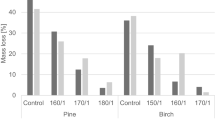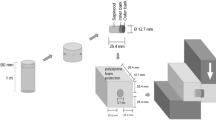Abstract
Outdoor log storage without protection can change the mechanical and chemical properties of wood due to infection by various fungi. To understand how outdoor log storage affects the wood and, subsequently, the strandboard quality, two piles of aspen logs were set up outside and stored for a period of four months (July to November). One of the piles was treated with a biological solution to prevent fungal growth. The other one was stored without treatment. Both piles contained non-debarked and partially debarked logs. Evaluation of sap stain development indicated that all logs had been colonized by staining fungi with average stain coverage of 9.37 to 57.18% and maximum stain penetration of 3.58 to 7.27 cm over the log cross section. The variation of fungal colonization depended on log treatment and bark condition. The most effective way to prevent stain growth was the combination of biological treatment and partial debarking. A series of strandboard was prepared from fresh and aged aspen logs. All boards made from stored logs were statistically comparable to or superior to the control boards made from fresh aspen logs. The boards made from treated/partially debarked and untreated/non-debarked logs were statistically comparable to each other except for wet MOR. In addition, these two board types were statistically stronger than other boards made from treated/non-debarked and untreated/partially debarked logs in terms of IB and water resistance. Some individual stained strands were observed on the finished board surface. Less staining was found in the boards prepared from biologically treated and partially debarked logs, compared with those made from other stored logs.
Zusammenfassung
Eine Lagerung von Holzstämmen im Freien ohne Schutzbehandlung kann zu Pilzbefall und damit zu Änderungen der mechanischen und chemischen Eigenschaften des Holzes führen. Um die Auswirkungen einer Freilagerung auf das Holz und somit auch auf die Eigenschaften von daraus hergestellten OSB-Platten besser verstehen zu können, wurden zwei Aspenholzstapel im Freien aufgebaut und über einen Zeitraum von vier Monaten (von Juli bis November) gelagert. Einer der Stapel wurde zur Vorbeugung von Pilzwachstum mit einer biologischen Lösung behandelt. Der andere Stapel wurde nicht behandelt. Beide Stapel enthielten sowohl nicht entrindete als auch teilweise entrindete Stammabschnitte. Die Untersuchung ergab, dass alle Stammabschnitte mit holzverfärbenden Pilzen besiedelt waren. Dabei betrug die verfärbte Oberfläche durchschnittlich 9.37 bis 57.18% und die maximale Eindringtiefe 3.58 bis 7.27 cm über den Querschnitt. Der unterschiedliche Pilzbefall hing von der Behandlung der Stammabschnitte und dem Anteil der Rinde ab. Die wirksamste Methode zum Schutz gegen holzverfärbende Pilze war die Kombination von biologischer Behandlung und teilweiser Entrindung. Eine Reihe von OSB-Platten wurde aus frischen und gelagerten Aspenholzstämmen gefertigt. Alle Platten aus den gelagerten Stammabschnitten waren mit den Kontrollplatten aus frischem Aspenholz statistisch vergleichbar oder höherwertig. Die Platten aus behandelten und teilweise entrindeten sowie unbehandelten und nicht entrindeten Stammabschnitten waren bis auf die Nassbiegefestigkeit statistisch vergleichbar. Die Querzugfestigkeit und die Wasserbeständigkeit dieser zwei Plattentypen waren besser als die der übrigen Platten aus behandelten und nicht entrindeten sowie aus unbehandelten und teilweise entrindeten Stammabschnitten. An den fertigen Plattenoberflächen waren vereinzelt verfärbte Strands zu sehen. Platten aus biologisch behandelten und teilweise entrindeten Stammabschnitten wiesen weniger Verfärbungen auf als Platten aus den anderen gelagerten Stammabschnitten.
Similar content being viewed by others
References
AMTB203 (1994) Test Method for Stroke Cure Test. Structure Board Association (SBA). Ontario, Canada
AMTB204 (1993) Fusion Diameter Test. Structure Board Association (SBA). Ontario, Canada
CSA Standard (1993) O437.1. Test Methods for OSB and Waferboard. Canadian Standard Association. Ontario, Canada
Curling SF, Clausen CA, Winandy JE (2002) Relationships between mechanical properties, weight loss, and chemical composition of wood during incipient brown rot decay. For Prod J 52(7–8):34–39
Desch HE, Dinwoodie JM (eds) (1988) Timber. Its Structure, Properties and Utilisation. Sixth Edition, Macmillan Education
Eaton RA, Hale MDC (eds) (1993) Insect and Marine Borer Attack of Wood, Part Two. In: Wood Decay, Pests and Protection. Chapman & Hall, London Glasgow New York Tokyo Melbourne Madras
Elowsson T, Liukko K (1995) How to achieve effective wet storage of pine logs (Pinus sylvestris) with a minimum amount of water. For Prod J 45(11–12):36–42
Florence EJM, Gnanaharan R, Singh PA, Sharma JK (2002) Weight loss and cell wall degradation in rubberwood caused by sapstain fungus Botryodiplodia theobromae. Holzforschung 56(3):225–228
Kennedy RW (1958) Strength retention in wood decayed to small weight losses. For Prod J 8(10):308–314
Pfaff F (1990) The Effect of log storage and waferizing fines on the quality of aspen wafers and waferboard. Project No. 03-38-12-M-209, Forintek Canada Corp
SAS (1999-2000) Release 8.01.1. SAS Institute Inc., Cary, NC, USA
Smith SM, Graham RD, Morrell JJ (1987) Influence of air-seasoning on fungal colonization and strength properties of Douglas fir pole sections. For Prod J 37(9):45–48
Smith SM, Morrell JJ, Sexton C (1992) Residual strength of Douglas fir sapwood and heartwood as affected by fungus colony size and number of colony forming units. For Prod J 42(4):19–24
Syme JH, Saucier JR (1995) Effects of long-term storage of southern pine sawlogs under water sprinklers. For Prod J 45(1):47–50
Wang XM, Wan H (2003) Outdoor storage of shavings and its impact on particleboard performance. Canadian Forest Service (CFS) Project No. 29, FCC Project No. 3232. Forintek Canada Corp
Wilcox WW (1978) Review of literature on the effects of early stages of decay on wood strength. Wood Fiber Sci 9(4):252–257
Yang DQ (2001) Staining ability of various sap-staining fungi on jack pine short log sections. For Prod J 51(2):73–76
Yang DQ, Beauregard R (2001) Sapstain development on Jack pine logs in eastern Canada. Wood Fiber Sci 33(3):412–424
Yang DQ, Lovell R (1997) Effect of pH on spore germination and mycelial growth of moulds and sap-staining fungi. Canadian Forest Service Project No. 26, Forintek Canada Corp
Yang DQ, Rossignol L (1999) Evaluation of Gliocladium roseum against wood-degrading fungi in vitro and on major Canadian wood species. Biocontrol Sci Technol 9:409–420
Author information
Authors and Affiliations
Corresponding author
Rights and permissions
About this article
Cite this article
Wang, XM., Wan, H., Yang, DQ. et al. Impact of Aspen Log Storage with and without Protection on OSB Performance. Holz Roh Werkst 64, 377–384 (2006). https://doi.org/10.1007/s00107-006-0106-z
Published:
Issue Date:
DOI: https://doi.org/10.1007/s00107-006-0106-z




